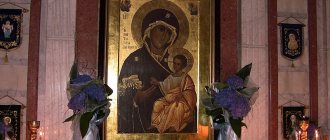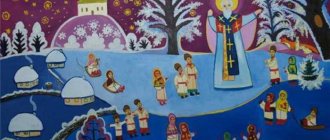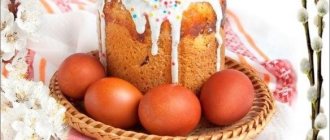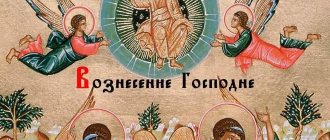What is the Annunciation, what kind of holiday?
So, in the second month of spring, on the 7th, the twelfth feast of the Annunciation is celebrated.
On this blessed day, the miraculous appearance of Archangel Gabriel to the Virgin Mary is remembered. He brought joyful and happy news: the Holy Virgin Mary was to become the Mother of the Savior of human souls. Maria accepted this mission with deep gratitude to the higher powers.
True believers believe that the Annunciation is one of the most joyful days of spring. It is considered one of the significant great celebrations of the Mother of God. The name of the holiday comes from the phrase good news. And this is no coincidence: the news of a good day gave hope and faith to every person living on earth. This means that the born Son of God will soon become the Savior of their sinful souls.
What date is this celebration celebrated, and does its date change according to the dates: according to the old style, the day of the Annunciation fell on March 25, and according to the new style, on April 7. The date is fixed, the holiday is permanent. In short, it is dedicated to events from the earthly life of the Mother of God and the Son of God Christ. This means that the celebration is included in the list of the great twelve.
Annunciation at the Well (second half of the 12th century)
Bibliothèque nationale de France / MS Grec 1208
Theologians who wrote about the Annunciation often speculated about how Mary felt at that moment, and only a few were interested in the experiences of the Archangel Gabriel. Among the latter is the monk Jacob Kokkinovathsky, who lived in the 12th century, and the author of six homilies. Homilia is a sermon explaining the passages of Holy Scripture read. about the life of the Virgin Mary. Gabriel was pretty frightened by the task entrusted to him. At first he entered Mary's house unseen and was amazed at her virtue - so much so that he could not find the right words. Deciding that he would scare her less on the street than at home, Gabriel decided to wait for Maria to go get water and tell her the news at the well (alas, this did not help and Maria was still scared).
The meeting at the well is illustrated by one of the manuscript miniatures. Mary stands with her back to Gabriel. Hearing his voice, she turns her head, raising one hand in fear and holding the jug with the other. This scene is often found in Byzantine and Old Russian art, in paintings dedicated to the Annunciation.
When is Annunciation in 2022? Celebration date
According to the calendar followed by church ministers and parishioners, in 2022, as in any other previous or subsequent year, Annunciation Day will be celebrated on April 7.
Between the Great Dates on which believers celebrate the holiday of Blagovest and Bright Christmas, there are exactly 9 months, which are necessary to bear a child.
The day before the start of the holiday, the forefeast is celebrated, and the day after it falls on the Council of the Archangel Gabriel. However, if Easter and the Annunciation are on the same day, or the date of the celebration coincides with Holy or Bright Week, then the forefeast and afterfeast, according to the rules of the Orthodox Church, are postponed.
Calendar and Annunciation
Christianity has relied on the Julian calendar from the very beginning because it was the calendar used by the Roman Empire. In the first 3 centuries, when there were still persecutions against Christians, there were no holidays as such. The first Christians performed divine services and revered Sunday, Wednesday and Friday as specific days of the passion of Christ.
Then separate holidays appeared, tied to the calendar. Among them is the Annunciation, as a key date, fixed for the entire season. Christmas - winter, Annunciation - spring, Nativity of John the Baptist (Ivan Kupala) - summer and Exaltation (Beheading) - autumn. Holidays began to be established and tied to a specific day in the 4th century. In 325, the First Ecumenical Council proclaimed that all Christian Churches, all Christian states should live according to one calendar - the Julian. And now for the Orthodox Russian, Serbian, Jerusalem and Georgian churches, plus for the Old Believers, the Julian calendar is in effect, unlike, for example, Catholics.
Ceiling fresco “The Annunciation” in the Church of Santa Maria Assunta (Cappella del Suffragio) by Teofilo Polacco (19th century), Riva del Garda, Italy
The history of the holiday and its meaning for believers
The names of Archangel Gabriel and the Virgin Mary are closely associated with the spring day of grace: Orthodox Christians celebrate the twelfth feast of the Annunciation. Events that served as the occasion for the celebration: the angel of good news appeared to the Holy Virgin Mary to inform her that she had been chosen to be the mother of the Son of God.
Blessed Mary was raised in the temple until she was 14 years old. It was decided by the clergy to marry the girl off. But she told them about her promise to the Almighty, that she would forever remain a virgin and would not become anyone’s wife. The girl went to live with her relative Joseph, an 80-year-old man. She led a solitary life, which was no different from her previous life within the walls of the temple.
The Annunciation of the Virgin Mary was first mentioned in the Gospel of Luke. Little information can be found in the New Testament describing the life of the Mother of God before the birth of Christ. There are many legends left, but it can be difficult to judge their reliability.
The Great Divine Annunciation in Orthodox culture means the unexpected appearance of an angel to Mary, bringing the happy news that she will become the mother of a sacred baby. The essence of the celebration: the gracious attitude of the Lord towards the Holy Mother of God. It seems to be contrasted with the attitude of the Almighty towards the first woman on Earth, Eve.
The main meaning of the celebration in Orthodoxy is the salvation of the human race. Thanks to the birth of God, Christ, who gave his life to atone for the sins of mere mortals. Thus, he gave an example of true faith and steadfastness of spirit.
Why did God choose the Virgin Mary to bring the Messiah into the world?
The Virgin Mary came from the family of King David, from the tribe of Judah, the seed of Abraham. According to the Old Testament prophets, the Savior was to be born into the family of King David. Mary's parents, according to their promise, gave Her to serve God.
Maria spent her childhood and youth in church, studying Scripture, praying, and doing handicrafts. The purity and immaculateness of the Virgin, extraordinary humility attracted the grace of God to her. Church tradition calls the Mother of God Most Pure, Immaculate, Most Holy, since She was purer, more perfect than all earthly beings and alien to personal sin. It was precisely for her extraordinary humility and purity that God chose the daughter of the family of King David to bring his Son to earth.
Church tradition calls the Most Holy Theotokos Heaven, the Ark of God, Paradise, the Ladder of Heaven, the Throne of the Most High, the Door of Salvation, the Blooming Rod.
Attributes and symbols of the holiday
The Christian holiday of April 7 is usually celebrated in the church in blue vestments. The clergy also use blue color for vestments during services on the days of pre-celebration and dedication. But this rule applies only to those days that do not fall during Holy Week.
The purity, piety and holiness of the Virgin Mary are personified by the snow-white flowers of the lily. The number of flowers in the bouquet is associated with the happy date of the celebration: 7 pieces. Also, the number 7 symbolizes the 7 joys of the Mother of God. If you celebrate the Annunciation at home, then delicate and fragrant flowers should be placed in the most prominent place.
How the Annunciation was celebrated
In all centuries, the Annunciation has been considered the most important Christian holiday. In honor of this event, special ceremonial services were held (and are still taking place) in churches. The people, of course, brought their own folklore notes to this great date. This refers to all sorts of signs, beliefs and hopes and hopes associated with them.
Firstly, since the Annunciation is celebrated in April, it was associated with the onset of spring, when nature awakened.
- The people claimed that on the Annunciation, birds begin to return from warmer climes to their native nests.
- On the day of the Annunciation, all kinds of animals that were in hibernation awaken and come out of their holes and dens: bears, hedgehogs, badgers, etc.
- On Annunciation, insects also awaken from a long winter hibernation. Therefore, on the eve of this day, the owners took out the hives with bees.
- There was a wonderful custom of releasing birds into the wild on Annunciation Day. People went en masse to the markets, bought birds there and opened the cage doors. Fly, birds!
- It was believed that before the Annunciation no earthwork could be carried out - neither plowing nor digging.
- On the Annunciation (since it was believed that spring had come), young people happily burned their old winter beds and moved to spend the night in haylofts and other free places.
- It was strictly forbidden to work at the Annunciation. There were even special proverbs about this. For example: “On Annunciation Day, no bird builds a nest.” Or: “On Annunciation, the devils in hell do not torment sinners.”
There were also special Annunciation signs, which, it must be said, always came true with amazing accuracy. Here are just a few of them.
- Ice drift begins either a week before the Annunciation, or exactly a week after it.
- If spring began before the Annunciation, it means there will still be frosts ahead.
- On Easter the weather will be the same as on Annunciation.
- If the night before the Annunciation is warm and quiet, then the whole spring will be the same.
- If there is fog on the morning of Annunciation, you should expect large floods.
- If it is cloudless and warm on Annunciation Day, it means that the summer will be hot, dry and fire hazardous.
- If frost hits on Annunciation, you should expect a good harvest of oats, and if it rains, then rye will grow.
And yet, early on the Annunciation morning, people met the sunrise. They say that on this holiday morning the sun rises in a special way; it seems to be “playing.” And everyone who sees this beauty will live happily ever after. Let's wait for the Annunciation and watch the sunrise! After all, Annunciation signs, as you know, come true.
Watch this video about the history of the Feast of the Annunciation:
Icons of the Annunciation of the Blessed Virgin Mary: what they help with
Since the advent of Christian teaching, the iconography of the celebration is represented by the following subjects:
Saint Gabriel brought good news. Having appeared to the Mother of God, he tells her about a joyful event that will soon happen in her life. Such a composition can include, for example, the Ustyug icon.
A composition that is made up of two different icons that together create a single image. In one image you can see Gabriel, and in the second - the Blessed Virgin Mary.
Icon of the Annunciation (Andrey Rublev):
Believers coming to the temple on April 7 are looking for the image of the Annunciation - the Icon of the Good News:
According to Orthodox people, this icon has miraculous powers. The holy image helps to heal spiritual wounds, as well as get rid of diseases. It is known to have been used:
- to recover from infertility and find the joy of motherhood;
- get rid of bad thoughts;
- become free from bad habits.
Jacopo Tintoretto. "Annunciation" (1576–1581)
Scuola Grande di San Rocco / Wikimedia Commons
In most depictions of the Annunciation, Mary is calm. She is not afraid at the sight of the archangel and humbly accepts the role assigned to her. Tintoretto's Annunciation is disturbing and chaotic. The picture is painted in dark colors, Gabriel bursts into the house, he is accompanied by a whirlwind of putti Putto (Latin putus - “little boy”) - a winged boy.; the dove, symbolizing the Holy Spirit, swoops down sharply, and Mary recoils in fear. There are no flowers or garden, and the house resembles ruins: straw sticks are coming out of the chair, boards and Joseph’s carpenter’s tools are carelessly piled behind the door. Behind the chair we see an old manger. To increase the tension, Tintoretto uses sharp perspective and a strange angle: the viewer seems to be looking at everything that is happening from above. The dynamic composition, impetuous movements and contrasting lighting anticipate the painting of the Baroque era, which preferred intense, dynamic, emotional scenes to the restrained Annunciations of previous centuries.
Prayers to the Blessed Virgin Mary
Mostly women turn to the Mother of God. What they ask for at the Annunciation: to give the joy of motherhood. Also on this day you can ask for deliverance from illnesses, for release from any imprisonment, for a blissful atmosphere in the family. For your wish to come true, you need to know what prayers to read.
The text of the prayer for marriage and against loneliness, which should be read on this holy holiday:
“I turn to you, O Most Holy Theotokos, with a request to raise my petition to Your Son. Grant me the opportunity to live in an honest marriage, bless my works and good thoughts. I ask this not to please my desire, but only because in the bonds of marriage I can fulfill my true destiny. For, according to the words of the Lord our God, it is bad for a person to live alone. I ask for a meeting with my future spouse, so that we can live in harmony with them and glorify you, Holy Virgin and Your Son. Amen".
Prayer for health to the Blessed Virgin Mary:
“Accept, O Almighty Mother of God, my prayer, offered to you with tears. Grant health to the weak, give help in healing illnesses, deliver the offended from insults, bring reason to the offenders, give strength to accept their lot and live in harmony with themselves. I worship your most pure image, I sincerely believe in your miraculous power. Amen".
Greatness
“Rejoice, O Most Pure and Gracious One, our Savior is always with you!”
Troparion
“On this joyful day, foreshadowing the beginning of the salvation of our souls, a sacred sacrament took place, which each of us praises. Saint Gabriel informed the Virgin that the Son of God would become her Son. Oh, Blessed Virgin, rejoice, the Almighty is with you!”
Kontakion
“To the Mother of God who covers us with her veil for deliverance from grief and bad luck, we bless Your triumph with gratitude from your servants, O Most Holy Mother of God! Free us from any adversity and deprivation, we glorify your name and say with deep respect: “Rejoice, Mother of God, who did not know the bonds of marriage!”
Holy Fathers on the Annunciation
Saint Elijah Minyatiy. Word on the Annunciation of the Mother of God:
“How different are God and man! But God, having become man, did not abandon the nature of Divinity in the perception of the flesh. And how different are the Virgin and the Mother! But the Virgin, having become a Mother, did not lose the glory of virginity in maternal pregnancy. What a strange communion of two natures - Divine and human, seamlessly united into one hypostasis! The divine nature adopted human characteristics, and God became a perfect man; the human became involved in the properties of the Divine, and the same man became perfect God.
In the same way, what an extraordinary combination of girlish purity and maternal pregnancy, which were strangely combined in one Wife! Virginity gave the Mother the purity that the Mother of God should have had, all pure, all immaculate, beautiful as the sun, chosen as the moon, as the Holy Spirit calls Her (see: Cantos 6, 9). Wombbearing gave virginity the blessing that the Virgin should have had in accordance with how the archangel greeted Her: Blessed are You among women
(Luke 1:28).
There this wonderful union was born - the God-Man; here another connection takes place, equally wonderful, the Virgin Mother. “Strange and wonderful and in many ways deviating from ordinary nature: one and the same Virgin and Mother, abiding in the sanctification of virginity and inheriting the blessing of childbearing,” proclaims the unappearing Basil. Such a Son, I repeat, must have such a Mother; the Son, who was born a man and did not cease to be God, has a Mother who gave birth to the Son and did not cease to be a Virgin.”
Saint Nicholas (Velimirović):
“Never has any spring water been such a pure mirror of the sun as the Most Pure Virgin Mary was a mirror of purity. (“O purity, creating joy for the heart and transforming the soul into heaven! O purity, good acquisition, not defiled by beasts! O purity, abiding in the souls of the meek and humble and creating these people of God! O purity, in the midst of the soul and body, like a flourishing flower and filling the whole temple with incense!" St. Ephraim the Syrian. About purity.
)
And the morning dawn, giving birth to the sun, would be ashamed before the purity of the Virgin Mary, who gave birth to the Immortal Sun, Christ our Savior. No knee will bow before Her, no mouth will cry out: “Rejoice, full of grace! Rejoice, Dawn of human salvation! Rejoice, Most Honest Cherub and Most Glorious Seraphim! Glory to Your Son, our Lord Jesus Christ, with the Father and the Holy Spirit - the Trinity, Consubstantial and Indivisible, now and ever, at all times and forever. Amen
«.
Holy Righteous John of Kronstadt. “The Beginning of Salvation” (Word on the Annunciation of the Blessed Virgin Mary):
“The sacrament that took place on this day amazes not only human, but also all angelic, high minds. They are also perplexed as to how the beginningless, immense, unapproachable God descended to the form of a slave and became a man, without ceasing to be God and without in the least diminishing the glory of the Divine? How could the Virgin contain the unbearable fire of the Divine in her most pure womb, and remain undamaged, and remain forever the Mother of God incarnate? So great, so wonderful, so full of Divine wisdom is this sacrament of the Annunciation of the Incarnation of the Son of God from Her by the Archangel to the Most Holy Virgin! Rejoice, earthly beings, rejoice, especially faithful Christian souls, but rejoice with awe before the greatness of the sacrament, as if surrounded by the filth of sin; rejoice, but immediately with sincere and living, deep repentance, cleanse yourself with the grace of God from the filth of sin.
Magnify with pure hearts and lips the Mother of God, exalted and exalted above all creatures, Angels and men, exalted by God Himself, the Creator of every creature, and remember that the mystery of the incarnation and incarnation of the Son of God took place for our salvation from sin, the curse righteously pronounced upon us in the beginning from God for sins, and from death, temporal and eternal. With fear and joy, accept the Lord who is coming to us to establish the Kingdom of Heaven on earth in our hearts and souls, the kingdom of truth, peace and joy in the Holy Spirit, and hate God-hating sin, malice, impurity, intemperance, pride, hard-heartedness, unmercifulness, selfishness , carnal knowledge, all untruths. Christ came to earth for this purpose, in order to raise us to heaven.”
Churches of the Annunciation in Russia
A large number of religious temples have been erected in Russia, which are dedicated to the bright April holiday.
One of the most significant is the Annunciation Cathedral, which is part of the Moscow Kremlin. The first building was wooden. It was erected at the turn of the XIII-XIV centuries. The base of the cathedral was made of stone. In the 15th century, the wooden temple was dismantled, and a stone cathedral was erected in its place. At the beginning of the 20th century, the building was occupied by the Bolshevik government. Now the cathedral is inactive, but it is open to visitors as a museum object.
In 1997, the wooden Annunciation Church was built in Moscow. It is made in the style of Russian wooden architecture of the 15th century. The church is functioning and is located on Yeniseiskaya Street.
In the Petrovsky Park in Moscow on Krasnoarmeyskaya Street in the mid-19th century, the foundation of the Annunciation Church was laid. The central altar was consecrated only 50 years after the laying of the first stone. The temple became operational starting in 1904.
Annunciation churches and monasteries
Beginning with the official recognition of the celebration, shrines began to be erected throughout Rus' in the name of the festival:
- Church of the Annunciation (Kyiv);
- temple of the Moscow Kremlin;
- Cathedral in Vitebsk;
- Murom monastery;
- monastery of the city of Kirzhach, as well as the village of Timoshkino (Vladimir region);
- Nikandrova Lavra (Pskov region);
- house church of the Suzdal Kremlin, etc.
Holy Annunciation Cathedral (Kharkov)
Annunciation Cathedral (Moscow Kremlin)
Annunciation Church (Vitebsk)
The great feast of the Annunciation of the Blessed Virgin Mary has been revered by Orthodox Christians since the time of the apostles. Today, in importance, it ranks alongside the Nativity of Christ and Great Easter.
If you find an error, please select a piece of text and press Ctrl+Enter.
Customs and traditions of celebration and how to celebrate
In Rus', people believed that the Annunciation was not only a Great Church celebration, but also a kind of beginning of a new life cycle. People believed that it was on April 7 that real spring began, which would then smoothly transition into the long-awaited summer. At this time, the earth was awakening from a long sleep.
It was customary to celebrate the joyful day in tranquility; there were no noisy celebrations. The creation of an atmosphere conducive to concentrated thought, which contributed to spiritual development, was welcomed. In silence, the mind rests, and the soul becomes closer to the Almighty.
Blagovest Day in its significance was sometimes compared with Easter. They said that this was one of the most important divine holidays. Therefore, any housework was not encouraged.
Why do they put money under the tablecloth at the Annunciation?
To increase wealth in the house, on a holiday it was customary to put money under the tablecloth on the table. The fact is that a tablecloth has always been considered an attribute of prosperity and a comfortable life. The money placed under it attracted new income and prosperity.
Why are birds released for the Annunciation?
In Rus' there is a custom on the Feast of the Annunciation to go outside with the whole family and release pigeons. This tradition has its roots in ancient times. It was believed that, when flying into the heavens, the birds would tell the angels they met along the way about the good deeds of people. Believers thereby allegedly absolved their sins. For these purposes, doves were most often used, which were considered a kind of symbol of good news. Now this custom with birds has been revived.
Robert Campin. "Annunciation" (1420–30s)
Metropolitan Museum of Art
An angel enters an ordinary burgher's house of that time. Maria is absorbed in reading and does not notice him. In a ray of light there is a figurine of Christ flying through the window. The Archangel has not yet had time to speak to the Virgin, and Kampen seems to use this pause to show the viewer the interior of the room. There are lilies on the table, a polished bronze washbasin in the corner, a book wrapped in cloth. All this hints at Mary's purity. The newly extinguished candle probably recalls the light that emanated from the newborn Jesus and outshone the candle flame. Perhaps this is Kampen’s way of emphasizing the humanity of Christ. In general, Kampen’s painting is an example of how difficult it can sometimes be to decipher 15th-century Dutch painting by choosing a specific meaning for a particular object. For example, the bench of the Virgin Mary, decorated with small carved lions, may symbolize the throne of Solomon, with which Mary was compared and which was also decorated with lions, and the lions themselves - Jesus. Or maybe Kampen painted the bench only because such furniture was in fashion in those years.
Nutrition. What can you eat on Annunciation?
According to the Church Charter, various food allowances are made on the church holiday, despite the fact that it most often falls during Lent. If Easter is celebrated earlier, then there are no restrictions on food. But this doesn't happen often.
On April 7, you can eat fish, you can eat seafood, but animal products should be completely excluded. You can drink wine, but in moderation. Consumption of clean water is allowed without restrictions. If the celebration coincides with Saturday of Holy Week (Passionate Annunciation), then fish and seafood are not eaten.
What you can do and what you can’t do
You should not do household chores on holiday. Everything that people do every day is prohibited. On April 7, they don’t sew, don’t embroider, don’t knit, don’t even braid their hair (they wear the same braid that was braided yesterday, or they wear it loose). This cannot be done because it is believed that the heavens are open on the holiday, and threads and hairs may accidentally become entangled with others, which will entail dramatic changes in fate. It is not recommended to wash in a bathhouse, but you can take a shower or a bath.
Household chores should be kept to a minimum. Food must be prepared in advance. It is forbidden to lend money, otherwise prosperity will leave the house. It is not customary to wear new things - this is considered a bad omen. Swearing and anger are unacceptable; on this holy holiday, you need to give up quarrels and any gossip.
Weddings and weddings are strictly prohibited. What you can do: pray at home and in church, attend the all-night vigil for the Annunciation on the night before the Annunciation, light candles, and have pious conversations with relatives.
Folk signs and superstitions
What did people believe in, what signs have been preserved since ancient times:
- Weather: if there is frost outside on the night of April 7 and snow falls, then expect a good harvest.
- If it rains like buckets in the morning, there will be a lot of mushrooms and berries;
- The swallows did not arrive by April 7 - spring will not please you with warmth;
- If you call your husband “beloved” 40 times on this day, then there will be peace and harmony in the family for many years.
- If you bury a piece of consecrated prosphora in the yard, the harvest will be generous.
- It was believed that on this day even a free bird does not build a nest, and a girl does not braid her long braids.
On the night of April 7, as a rule, prophetic dreams occur. However, they will not come true soon. They are an indicator of what will happen to a person in the future (perhaps they will come true in a few years).
There is a belief that children born on April 7, Annunciation, will not be happy. But this is not always true. After all, to be born on a Great Celebration is already a kind of gift from heaven. And, if such a beautiful date has been chosen from above, it means that the baby will have many joyful events in life. Giving birth on the Annunciation was considered not a very good omen. But, if you are lucky enough to become a mother on this day, you need to be grateful to the Lord for it.
They say that those who die at the Annunciation go to heaven. There is a lot of controversy about this. A person could lead a sinful life, and the date of his death simply coincides with the Great Day.
Alexander Ivanov. "Annunciation" (1850)
State Tretyakov Gallery / wikiart.org
Archangel Gabriel was sent from heaven to earth to inform Mary of her destiny. The artist emphasizes that Mary and Gabriel belong to different worlds by depicting them on different scales. The Archangel is not just taller than Mary - their figures are incommensurate with each other. At the same time, they are combined compositionally: the angel’s hand falls into the circle of radiance emanating from Mary.
Ivanov's Annunciation is unexpectedly monumental - especially considering that it is watercolor on paper. At the end of the 1840s, the artist conceived a series of paintings on biblical subjects, and this watercolor sketch was supposed to later become a fresco (but it never did). At this time, Ivanov was reading the book “The Life of Jesus” by the German theologian David Strauss. Strauss believed that gospel miracles were mythologized legends, often based on Old Testament stories, and drew parallels between Old and New Testament stories. That is why Ivanov was going to write next to the scene of the Annunciation the appearance of the Trinity to Abraham.
Questions and answers
| Who is the Feast of the Annunciation dedicated to? |
| The celebration glorifies the Most Pure Virgin Mary and Saint Gabriel, who brought the joyful news of imminent motherhood. |
| Why is the holiday called Annunciation? |
| The name comes from the phrase good news. |
| Is it possible to cook on Annunciation Day? |
| It is not recommended to prepare food on this day; it is advisable to do it in advance. |
| Is it possible to sign for the Annunciation? |
| You can sign at the registry office, but noisy celebrations are prohibited. |
| Why are birds released into the wild on Annunciation Day? |
| So that they meet angels in heaven and tell them about the good deeds of people. |
| How many days is the Annunciation? |
| 1 day – April 7 |
| Does the date of the Annunciation change from year to year? |
| No, the holiday is permanent. |
| Is it possible to wash? |
| In the shower and bath - yes. |
Literature
- Martene E. De antiquis ecclesiae ritibus. Antw., 1737. Vol. 3. P. 588;
- Khojnacki A., priest. Feast of the Annunciation of the Mother of God in the Roman Catholic Church // PO. 1873. No. 6. P. 1001-1011;
- Vinogradov N. Canon for the Annunciation of the Most Holy. The Mother of God as an example of church liturgical poetry. M., 1888;
- Debolsky G.S., prot. Days of worship of the Orthodox Church. St. Petersburg, 1901. M., 1996. T. 1. P. 121-128;
- Kellner H. Heortologie oder das Kirchenjahr und die Heiligenfeste in ihrer geschichtlichen Entwicklung. Freiburg i. Br., 1901. S. 196;
- Conybeare FC Rituale Armenorum, being the Administration of the Sacraments and the Breviary Rites of the Armenian Church. Oxf., 1905;
- Cabrol F. Annonciation (Fête de l') // DACL. Vol. 1. T. 2. Col. 2241-2255;
- Petrovsky A. Annunciation // PBE. T. 2. P. 619-622;
- Kekelidze K., prot. Jerusalem Canonary of the 7th century (Georgian version). Tiflis, 1912;
- Skaballanovich M. Nativity of Christ. K., 1915. M., 1995r. (Christian holidays; 4);
- aka. Dormition of the Most Holy Mother of God. K., 1916. M., 1995r. (Christian holidays; 6);
- Veniamin (Milov), bishop. Readings on liturgical theology. K., 19992;
- Mirkoviě L. Heortology or historically developed liturgical services of the Orthodox Church. Beograd, 1961. P. 44-46;
- Θουντούλης ̓Ι. Εὐαγγελισμὸς τῆς Θεοτόκου // ΘΗΕ. Τ. 5. Σ. 980-982;
- Μπεκατῶρος Γ. Γ. Εὐαγγελισμὸς τῆς Θεοτόκου: Τάξις λατρείας // Ibid. Σ. 982-983;
- Οἰκονομίδης Δ. Β. Εὐαγγελισμὸς τῆς Θεοτόκου: Λαογραφία // Ibid. Σ. 983-985;
- Grosdidier de Matons J. Romanos le Mélode: Hymnes. P., 1965. T. 2. P. 20-40. (SC; 110);
- The most ancient Iadgari / Ed., research. and comment. E. P. Metreveli, T. A. Chankieva and L. M. Khevsuriani. Tbilisi, 1980;
- Argan J.K. History of Italian art: Trans. from Italian M., 1990. T. 1;
- Corrado M. Annunciazione: storia, eucologia, theologia, liturgica. R., 1991;
- New Testament Apocrypha. St. Petersburg, 2001;
- Kazhdan A.P. History of the Byzantines. Literature: 650-850 St. Petersburg, 2002.











